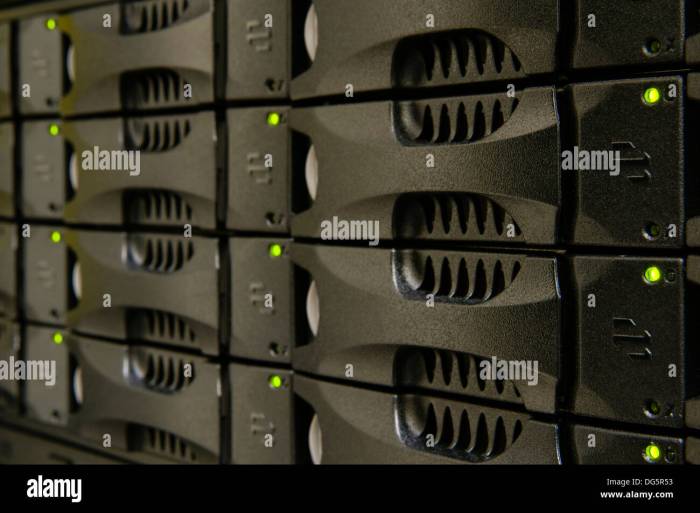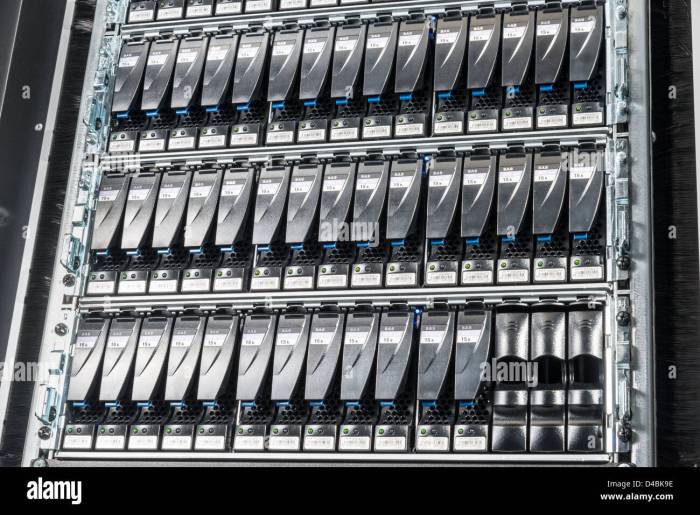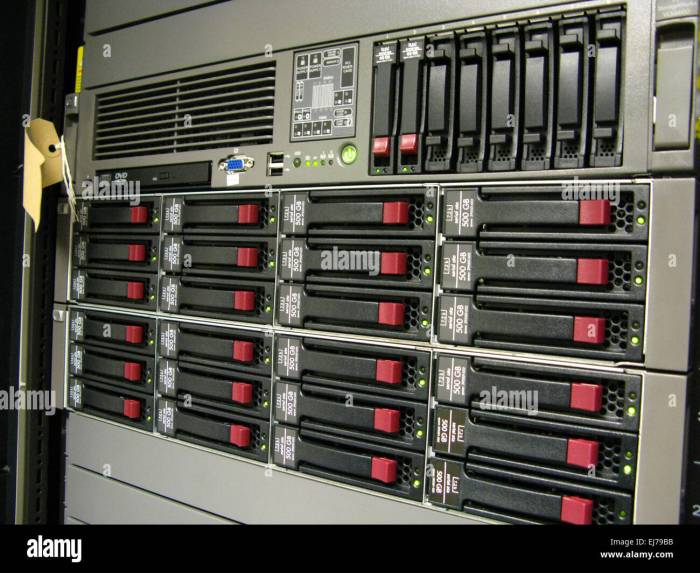Cloud data centers server hard drive types are way more complex than you might think! We’re talking terabytes of data, massive performance differences, and a whole lot of choices. This deep dive explores the world of HDDs versus SSDs, different form factors, and the tech that makes it all tick. Get ready to level up your understanding of the infrastructure that powers the internet.
From the humble 3.5-inch HDD to the blazing-fast NVMe SSD, the options for storing data in a cloud data center are vast. We’ll cover the pros and cons of each, including performance metrics like read/write speeds and latency, as well as the cost implications of choosing one type of drive over another. We’ll also explore how different workloads – think archival storage versus high-performance computing – influence the best choice for your specific needs.
Plus, we’ll peek into the future of cloud storage and what’s on the horizon.
HDD vs. SSD in Cloud Environments

The choice between hard disk drives (HDDs) and solid-state drives (SSDs) for cloud data centers is a crucial one, significantly impacting performance, cost, and overall infrastructure efficiency. Understanding the strengths and weaknesses of each technology is vital for optimizing cloud deployments based on specific workload requirements. This comparison will delve into the performance differences, cost implications, and suitability for various cloud workloads.
Performance Characteristics of HDDs and SSDs
HDDs and SSDs differ dramatically in their performance characteristics. SSDs, leveraging flash memory, offer significantly faster read and write speeds, lower latency, and improved durability compared to HDDs, which rely on spinning platters and read/write heads. This performance disparity directly impacts application responsiveness and overall system efficiency.
| Characteristic | HDD | SSD |
|---|---|---|
| Read Speed | 50-200 MB/s | 500-7000 MB/s |
| Write Speed | 50-200 MB/s | 500-3500 MB/s |
| Latency | 5-10 ms | 0.1-1 ms |
| Power Consumption | Higher (6-20W) | Lower (2-15W) |
Note: These are general ranges; actual speeds and power consumption vary widely based on specific drive models and technologies.
Cost Implications of HDDs and SSDs
SSDs currently command a significantly higher price per gigabyte than HDDs. This cost difference is a primary factor influencing storage choices in cloud environments. While the higher upfront cost of SSDs is undeniable, the performance benefits can translate into reduced operational costs through faster application processing, improved efficiency, and potentially lower energy consumption depending on workload. For example, a company running a large-scale database might find the higher initial investment in SSDs justified by the substantial performance gains and reduced operational downtime.
Suitability for Different Cloud Workloads
HDDs and SSDs are suitable for different types of cloud workloads. HDDs, due to their lower cost per gigabyte, remain a cost-effective solution for archiving large amounts of data that doesn’t require frequent access, such as long-term backups or infrequently used data sets. Examples include storing historical logs or inactive user data. Conversely, SSDs are ideal for applications demanding high performance, such as databases, virtual machine storage, and high-performance computing (HPC) environments.
The low latency and high throughput of SSDs ensure fast application response times, crucial for applications like online gaming or real-time data analytics. For instance, a cloud provider offering virtual machines would likely use SSDs for boot volumes to provide fast boot times and improve the overall user experience.
Hard Drive Capacity and Performance Considerations
Choosing the right hard drive for your cloud data center involves a careful balancing act between capacity and performance. More storage space doesn’t automatically translate to faster speeds, and sometimes, prioritizing one over the other is a strategic decision based on the specific workload. Understanding this relationship is key to optimizing your infrastructure’s efficiency and cost-effectiveness.The relationship between hard drive capacity and performance is often inverse, especially when comparing HDDs and SSDs of similar price points.
Further details about cloud configuration server is accessible to provide you additional insights.
Generally, higher-capacity HDDs tend to have slower rotational speeds and seek times compared to their lower-capacity counterparts. This is because larger platters require more time to spin up and for the read/write heads to move across the surface. SSDs, on the other hand, don’t suffer from this mechanical limitation as significantly, but even with SSDs, extremely large capacities can sometimes lead to slightly reduced performance due to factors like controller architecture and flash memory management.
For example, a 1TB SSD might boast faster sequential read/write speeds than a 16TB SSD, even though both are NVMe drives. This isn’t always the case, but it’s a trend to be aware of.
Impact of Storage Protocols on Hard Drive Performance, Cloud data centers server hard drive types
Different storage protocols significantly influence hard drive performance within a cloud data center. iSCSI, for example, uses standard Ethernet networks to transmit data, which can introduce latency compared to dedicated Fibre Channel networks. Fibre Channel, a dedicated high-speed protocol, typically offers lower latency and higher throughput, making it suitable for applications demanding extremely high performance, such as databases or high-frequency trading systems.
The choice between iSCSI and Fibre Channel often comes down to a trade-off between cost and performance. iSCSI is generally more affordable to implement, while Fibre Channel provides a performance boost that justifies its higher cost in specific scenarios. For example, a large-scale video editing and rendering farm would likely benefit greatly from the speed of Fibre Channel, whereas a less demanding application like file storage might be perfectly served by iSCSI.
Strategies for Optimizing Hard Drive Performance in a Cloud Data Center
Optimizing hard drive performance in a cloud environment involves a multi-faceted approach. One key strategy is to employ efficient storage tiering, where frequently accessed data is stored on faster media (like SSDs) while less frequently accessed data resides on slower, higher-capacity storage (like HDDs). This approach combines the speed of SSDs with the cost-effectiveness of HDDs. Another effective technique is data deduplication, which eliminates redundant data copies, thus reducing storage space requirements and improving performance by reducing the amount of data that needs to be read and written.
Furthermore, employing caching mechanisms, both at the hardware and software levels, can significantly boost performance by storing frequently accessed data in faster memory, reducing the load on the hard drives themselves. Finally, optimizing the storage array’s configuration, including RAID levels and controller settings, plays a crucial role in maximizing performance and ensuring data redundancy and protection. For instance, RAID 10 offers both redundancy and performance, making it a suitable choice for applications requiring both high availability and speed.
Future Trends in Cloud Data Center Hard Drives: Cloud Data Centers Server Hard Drive Types

The relentless demand for faster, more efficient, and higher-capacity storage in cloud data centers is driving innovation in hard drive technology. We’re moving beyond the traditional HDD/SSD dichotomy, exploring new memory technologies that promise to revolutionize data storage and retrieval. This evolution will significantly impact cloud infrastructure design, operational costs, and the overall user experience.Emerging technologies are poised to reshape the landscape of cloud data center hard drives in the coming years.
These advancements aim to address the limitations of current HDDs and SSDs, offering significant improvements in speed, density, and cost-effectiveness.
Persistent Memory and Storage-Class Memory
Persistent memory (PM) and storage-class memory (SCM) represent a paradigm shift in data storage. Unlike traditional RAM, which loses data when power is lost, PM retains data even after a power outage. This characteristic makes it ideal for caching frequently accessed data, reducing latency and improving application performance. SCM, on the other hand, sits between traditional DRAM and NAND flash in terms of speed and cost, offering a compelling alternative for high-performance computing and large-scale data analytics.
Imagine a scenario where databases are loaded directly into PM, eliminating the time-consuming process of reading from slower storage devices. This would drastically improve response times for applications relying on massive datasets, such as machine learning models or real-time data processing systems. The integration of PM and SCM will lead to a tiered storage architecture, optimizing cost and performance by placing frequently accessed data in faster tiers and less frequently accessed data in slower, more cost-effective tiers.
Impact on Cloud Data Center Design and Operation
The adoption of PM and SCM will significantly influence cloud data center design and operation. Firstly, it will lead to a reduction in the number of physical servers needed to support the same workload. The increased speed and capacity of PM and SCM will allow for greater density, leading to more efficient use of space and power. Secondly, the improved performance will reduce the latency experienced by applications, leading to a more responsive and efficient cloud infrastructure.
Thirdly, the improved durability and reliability of PM will reduce the risk of data loss and downtime, resulting in increased operational stability. For example, a cloud provider could leverage PM to create a highly available and fault-tolerant storage system, ensuring business continuity even in the event of hardware failures. This reliability translates directly to improved customer satisfaction and reduced operational costs for the cloud provider.
Anticipated Evolution of Hard Drive Technology (2024-2034)
The next 5-10 years will witness a gradual but significant shift in hard drive technology within cloud data centers.
| Year | Technology Trend | Impact |
|---|---|---|
| 2024-2026 | Wider adoption of NVMe SSDs; Increased capacity and performance of HDDs. | Improved I/O performance for many cloud workloads; cost-effective mass storage remains crucial. |
| 2027-2029 | Initial deployment of PM and SCM in high-performance computing environments. | Significant performance improvements for specific applications, like databases and AI workloads; higher initial costs. |
| 2030-2034 | More widespread adoption of PM and SCM; development of new, denser storage technologies (e.g., advanced 3D NAND). | Improved cost-performance ratio for PM and SCM; greater storage density for all storage tiers; potentially disruptive new technologies emerge. |
Power Consumption and Efficiency

Power consumption is a major consideration in cloud data center design, significantly impacting both operational costs and environmental sustainability. Hard disk drives (HDDs) and solid-state drives (SSDs) differ substantially in their energy needs, with implications for the overall efficiency of a data center’s storage infrastructure. Understanding these differences and implementing effective power management strategies is crucial for optimizing both cost and environmental impact.The energy consumption of HDDs and SSDs varies considerably based on capacity and activity levels.
A hypothetical bar chart comparing energy consumption would show a clear trend: higher capacity drives, in both HDD and SSD categories, generally consume more power, especially during sustained read/write operations. However, even at the same capacity, HDDs consistently consume significantly more power than SSDs due to their mechanical nature. The spinning platters and read/write heads of HDDs require considerable energy, whereas SSDs, relying on electronic storage, have substantially lower power demands, especially in idle states.
The difference becomes particularly pronounced when comparing large-capacity drives (e.g., 16TB HDD vs. 16TB SSD).
HDD and SSD Power Consumption Differences
The power difference between HDDs and SSDs stems from their fundamental operating mechanisms. HDDs, being mechanical devices, require continuous power to spin their platters and move the read/write heads. Even in idle states, they consume a noticeable amount of power. SSDs, conversely, consume significantly less power, both during operation and in idle states. This is because they lack the moving parts of HDDs, relying on electronic storage and transfer of data.
The power difference is most noticeable in high-capacity drives where the difference in energy consumption can be substantial, potentially leading to significant cost savings and reduced environmental impact when using SSDs at scale. For example, a large-scale data center using thousands of drives could see a considerable reduction in its overall energy bill by switching to SSDs.
Strategies for Optimizing Power Consumption in Cloud Data Center Storage
Optimizing power consumption in cloud data center storage involves a multi-pronged approach. This includes careful drive selection based on workload requirements, implementing power-saving features offered by storage hardware and software, and employing efficient cooling systems. Choosing the right drive for the task is paramount. High-performance SSDs may be justified for applications requiring high I/O, but for archival data, lower-power HDDs or even cloud storage solutions might be more cost-effective and energy-efficient.
Data center operators can leverage power management features built into many storage arrays and servers, such as drive spin-down during periods of inactivity and intelligent power management algorithms. These features dynamically adjust power consumption based on real-time workload demands. Furthermore, optimizing cooling systems is crucial because excessive heat increases power consumption. Efficient cooling techniques reduce the energy required for maintaining optimal operating temperatures.
Environmental Impact of Hard Drive Energy Consumption
The environmental impact of hard drive energy consumption in large-scale data centers is substantial. Data centers are significant consumers of electricity, contributing to greenhouse gas emissions. The cumulative energy consumption of millions of hard drives in these facilities contributes considerably to this environmental burden. The carbon footprint associated with powering these drives is a growing concern, especially as the demand for cloud storage continues to increase.
The shift towards more energy-efficient SSDs, coupled with improved power management practices, is crucial in mitigating this environmental impact. Strategies such as using renewable energy sources to power data centers and investing in more energy-efficient cooling systems can further reduce the environmental footprint of cloud storage.
So, there you have it – a whirlwind tour of cloud data center server hard drive types. Choosing the right drive isn’t just about capacity; it’s a balancing act between performance, cost, and the specific demands of your applications. Understanding the nuances of HDDs, SSDs, and their various interfaces is crucial for building a robust and efficient cloud infrastructure.
Hopefully, this exploration has given you a solid foundation to make informed decisions and optimize your data center’s performance.
FAQ Corner
What’s the difference between SATA, SAS, and NVMe SSDs?
SATA is the oldest and slowest, SAS offers better performance and reliability, while NVMe is the fastest but often most expensive interface.
How often do server hard drives typically fail?
Failure rates vary widely depending on the drive type and manufacturer, but MTBF (Mean Time Between Failures) is a key metric to consider. Redundancy and backups are essential to mitigate risk.
What’s the impact of hard drive type on energy consumption?
SSDs generally consume less power than HDDs, especially at higher capacities, contributing to lower energy bills and a smaller carbon footprint.
What are some strategies for optimizing hard drive performance in a cloud environment?
Strategies include using RAID configurations for redundancy and performance, employing efficient storage protocols, and regularly monitoring drive health.